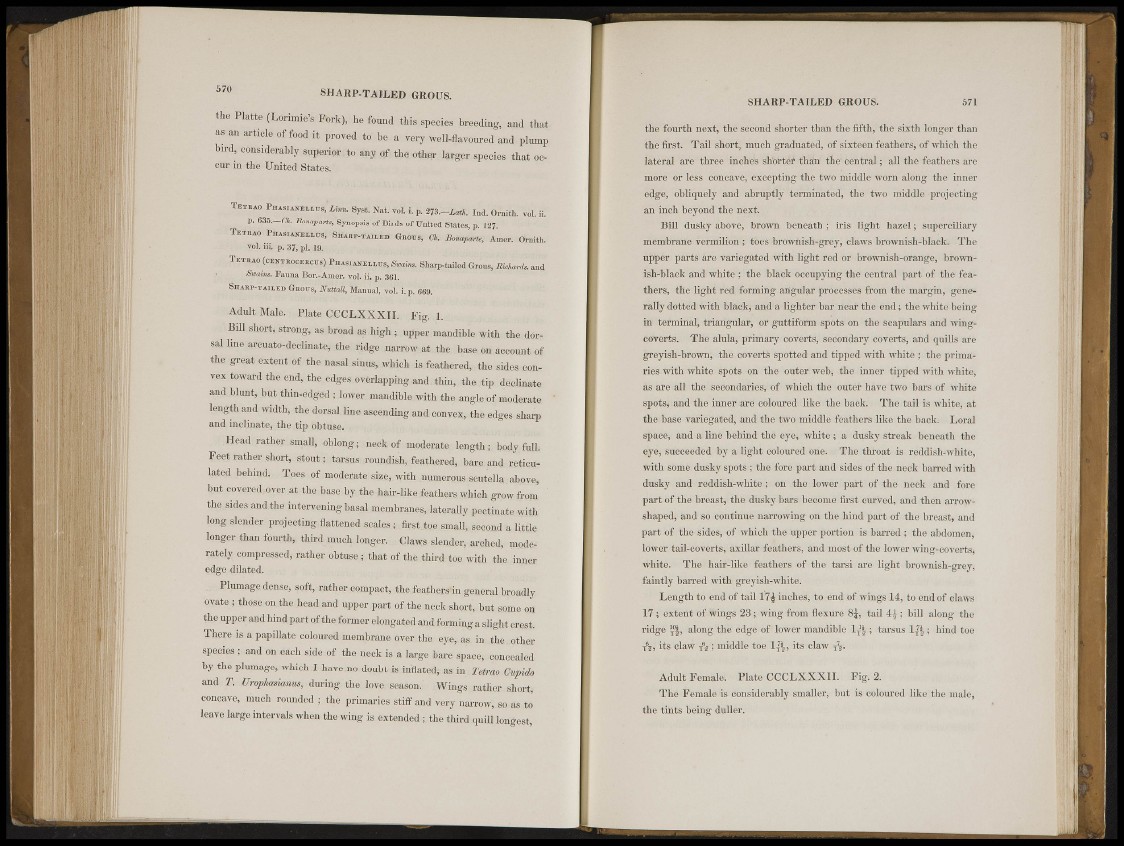
570 SHARP-TAILED (¡ROUS.
the Platte (Lorimiel, Bbrk), he found this eipeeJes breeding, and tha^
a S ^ ^ I t t r f food it proved to- be » very weU-flavoured and plump
bird, considerably superior to any 0 the ottflr lajger specfes that occur
m tiie United States,"-
i , B y * . Nat. volJ. Ind. OÎaitt. VoL.ffi
p.Î>35—SotuparU, Synopsis of Birds of United States, p 127
|M T > : F H A . I I ' H A S I A S E , ( Î K O R » , m. SoTKipém,'ON.IT!,.
. TKIHAO ^KNIHO^ECU») S^ . S I a i j -Me d GronsKB«^. I d
Swams. Fauna Bor.-Amer. vol. ii. p. 361.
SHARP-TAILED GROTJS, NuttaU, Manual, voi. i. p. 669.
Adult Male. ; Plate CÇCLXXXII. Fig. 1.
Bill.short« strong, as broad as high | upper mandible ^ith the dor*
sal line arcuato-declinate, the ridge narrow at the base on account of
the great extent of the nasal sinus, which i s feathered, the sides. c.on.
vex toward the end, the edges overlapping and, thin, the ,tip declinate
and blunt, but thin-edged ; .lower .mandible with the angle of moderate
length and width, the dorsal line ascending and convex, the edges sharp
and inclinât©, the tip obtuse. ,
Head rather small, oblong; neck of moderate length;, body full.
Feet rather short, stout; tarsus roundish, feathered, bare and reticulate<
l behind. Toes of moderate size, with numerous scutella above,
but covered,over at the base by the hair-like feathers which grow from '
the, sides and.the intervening basal m emb r e s , laterally pectinate with
long slender projecting flattened scales ; first toe small, second a little
longer than fourth, third much longer. Claws slender, arched, mode,
rately compressed, rather obtuse ; that of the third toe with the inner
edge dilated.
Plumage dense, soft, rather compact, the feathers'in general broadly
ovate ; those on the head and upper part of the neck short, but some on
the upper and hin d part of the former elongated and forminga slight crest.
There is a papillate coloured membrane over the eye, as in the other
species ; and on each side of the neck is a large bare Space* concealed
by the plumage-, which.I have.no doubt is inflated,- as in Tetrao Cwpido
and T I Uroplmianus, during the love, season. Wings rather short,
concave, much rounded ; the primaries stiff and very narrow,, so as to
leave large intervals when the wing is extended ; the third quill longest,
SHARP-TAILED GROUS. 571
the fourth next, the second shorter than the fifth, the sixth longer than
the first. Tail short, much graduated, of sixteen feathers, of which the
lateral are three inches sh'ortéi thâSn the central ; all the feathers are
more or less concave, excepting the two middle worn along the inner
edge, obliquely and abruptly terminated, the two middle projecting
an inch beyond the next.
Bill dusky above, brown beneath ; iris light hazel ; superciliary
membrane vermilion ; tbes brownish-grey, claws brownish-black. The
upper parts are variegated with light red or brownish-orange, brownish
black and white ; the black occupying the central part of the feathers,
the light red forming angular processes from the margin, generally
dotted with black* and a lighter bar neai* the end ; the white being
in terminal, triangular, or guttiform spots on the seapulars and wingcoVeris.
The alula, primary coverts, secondary coverts, and quills are
greyish-brown, the covertà spotted and tipped with white ; the primaries
with white Spots on the outer web, the inner tipped with white,
as are all the secondaries, of which the outei* have two bars of white
spots, and the inner are coloured like the back. The tail is white, at
the base variegated, and the two middle feathers like the back. Loral
space, and a line behind thè eye* white ; a dusky streak beneath the
eye, succeeded by a light coloured one. The throat is reddislpwhite,
with some dusky spots ; the fore part and sides of the neck barred with
dusky and reddish-white ;- on the lower part of the neck and fore
part of the breast, the dusky bars become first curved, and then arrowshaped,
and so continue narrowing on the hind part of thé breast, and
part of the sides, of which the upper portion is barred ; the abdomen,
lower tail-covérts, axillar feathers, and most of the lower wing-coverts,
white. The hair-like feathers of the tarsi are light brownish-grey,
faintly barred with greyish-white.
Length to end of tail inches, to end of wings 14, to end of claws
17 ; extent of Wings 23 ; wing from flexure tail ; bill along the
ridge along the edge of lower mandible ; tarsus ; hind toe
its claw ; middle toe its claw
Adult Female'. Plate CCCLXXXII. Fig. 2.
The Female is Considerably smaller, but is coloured like the male,
the tihts being duller.